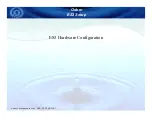
Mega Moon
™ User Manual
12
9/16/2010 4:11 PM
Contact Us
W o r l d W i d e
General Information
CHAUVET®
5200 NW 108
th
Ave
Sunrise, FL 33351
voice:
954.929.1115
fax:
954.929.5560
toll free: 800.762.1084
Technical Support
CHAUVET®
5200 NW 108
th
Ave
Sunrise, FL 33351
voice:
954.929.1115
(Press 4)
fax:
954.929.5560
(Attention: Service)
World Wide Web
www.chauvetlighting.com
5.
A
PPENDIX
DMX Primer
The DMX mode enables the use of a universal DMX controller device. There are 512 channels in a
DMX-512 connection. Channels may be assigned in any manner. A fixture capable of receiving DMX
512 will require access to one or more sequential channels. To do this, each fixture requires a "start
address" from 1 to 512. A fixture requiring one or more channels for control begins to read the data
on the channel indicated by the start address. For example, a fixture that uses six DMX channels and
was addressed to start on DMX channel 100, would read data from channels: 100, 101, 102, 103,
104, and 105.
The user must assign a starting address on the fixture that indicates the first channel reserved in the
controller. There are many different types of DMX controllable fixtures and they all may vary in the
total number of channels required. Choosing a start address should be planned in advance. Channels
should never overlap. If they do, this will result in erratic operation of the fixtures whose starting
address are set incorrectly. However, you can control multiple fixtures of the same type using the
same starting address as long as the intended result is that of unison movement or operation. In other
words, the fixtures will be slaved together and they will all respond in exactly the same way.
DMX fixtures are designed to receive data through a serial DMX Daisy Chain. In a Daisy Chain, the
DATA OUT of one fixture connects to the DATA IN of the next fixture. The order in which the fixtures
are connected is not important and has no effect on how a controller communicates to each fixture.
Use an order that provides for the easiest and most direct cabling, however.
Connect the fixtures using a shielded, two-conductor twisted pair cable with one 3-pin XLR male
connector on one end and a 3-pin XLR female connector on the other end. The shield connection is
pin 1, while pin 2 is Data Negative (S-) and pin 3 is Data positive (S+). See page 6 for details on this
type of cable.
































